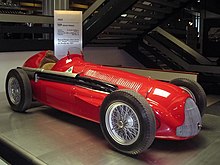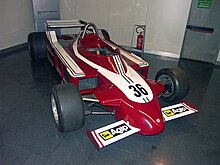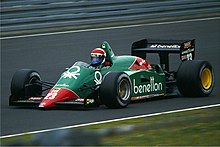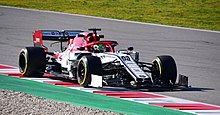Motor Racing Developments Ltd., commonly known as Brabham, was a British racing car manufacturer and Formula One racing team founded in 1960 by Australian driver Jack Brabham and British-Australian designer Ron Tauranac. The team won four FIA Formula One Drivers' and two Constructors' World Championships in its 30-year history, starting out with back-to-back wins of both in 1966 and 1967. Jack Brabham's 1966 Drivers' Championship remains the only such achievement using a car bearing the driver's own name.
Formula One, commonly known as Formula 1 or F1, is the highest class of international racing for open-wheel single-seater formula racing cars sanctioned by the Fédération Internationale de l'Automobile (FIA). The FIA Formula One World Championship has been one of the world's premier forms of racing since its inaugural running in 1950. The word formula in the name refers to the set of rules all participants' cars must follow. A Formula One season consists of a series of races, known as Grands Prix. Grands Prix take place in multiple countries and continents on either purpose-built circuits or closed public roads.
Scuderia Ferrari, currently competing as Scuderia Ferrari HP, is the racing division of luxury Italian auto manufacturer Ferrari and the racing team that competes in Formula One racing. The team is also known by the nickname "The Prancing Horse", in reference to their logo. It is the oldest surviving and most successful Formula One team, having competed in every world championship since 1950.

The 1979 Italian Grand Prix was a Formula One motor race held on 9 September 1979 at Monza. It was the thirteenth race of the 1979 World Championship of F1 Drivers and the 1979 International Cup for F1 Constructors.

The 1984 British Grand Prix was a Formula One motor race held at Brands Hatch, Kent, England on 22 July 1984. It was the tenth race of the 1984 Formula One World Championship.

The 1984 Italian Grand Prix was a Formula One motor race held at Monza on 9 September 1984. It was the fourteenth race of the 1984 Formula One World Championship.

The 1985 Australian Grand Prix was a Formula One motor race held on the Adelaide Street Circuit in Adelaide on 3 November 1985. The sixteenth and final race of the 1985 Formula One World Championship, it was the 50th running of the Australian Grand Prix and the first to be held on the streets of Adelaide on a layout specifically designed for the debut of the World Championship in Australia. The race was held over 82 laps of the 3.780 km (2.362 mi) circuit for a total race distance of 310 kilometres. The race was won by Keke Rosberg driving a Williams-Honda; this was the final win for Rosberg, the last race for Alfa Romeo until 2019, and the last by a Finnish driver until Mika Häkkinen won the 1997 European Grand Prix.
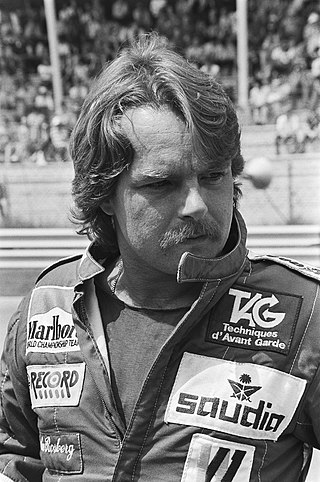
The 1982 FIA Formula One World Championship was the 36th season of FIA Formula One motor racing. It included two competitions run over the course of the year, the 33rd Formula One World Championship for Drivers and the 25th Formula One World Championship for Constructors. The season featured sixteen rounds between 23 January and 25 September. The Drivers' Championship was won by Keke Rosberg and the Constructors' Championship by Scuderia Ferrari.

Sauber Motorsport AG is a Swiss motorsport engineering company. It was founded in 1970 by Peter Sauber, who progressed through hillclimbing and the World Sportscar Championship to reach Formula One in 1993. Sauber operated under their own name from 1993 until 2005 and from 2011 until 2018. They were known as BMW Sauber from 2006 to 2010 and as Alfa Romeo from 2019 to 2023 in partnership deals with BMW and Alfa Romeo respectively. Sauber returned in 2024 as Stake F1 Team Kick Sauber, and is set to be the Audi works team from 2026 onwards, with the German outfit planning to acquire the Swiss team.

Carlo Chiti was an Italian racing car and engine designer best known for his long association with Alfa Romeo's racing department. He also worked for Ferrari and was involved in the design of the Ferrari 156 Sharknose car, with which Phil Hill won the 1961 championship.

During its history, Alfa Romeo has competed successfully in many different categories of motorsport, including Grand Prix motor racing, Formula One, sportscar racing, touring car racing and rallies. They have competed both as a constructor and an engine supplier, via works entries and private entries. The first racing car was made in 1913, three years after the foundation of A.L.F.A., the 40/60 HP had 6-litre straight-4 engine. Alfa Romeo quickly gained a good name in motorsport and gave a sporty image to the whole marque.

The 1981 South African Grand Prix was a Formula Libre motor race held on 7 February 1981 at Kyalami.
Formula One sponsorship liveries have been used since the 1968 season. Before the arrival of sponsorship liveries in 1968 the nationality of the team determined the colour of a car entered by the team, e.g. cars entered by Italian teams were rosso corsa red, cars entered by French teams were bleu de France blue, and cars entered by British teams were British racing green. Major sponsors such as BP, Shell, and Firestone had pulled out of the sport ahead of this season, prompting the Fédération Internationale de l'Automobile to allow unrestricted sponsorship.

The BMW M1 Procar Championship, sometimes known simply as Procar, was a one-make auto racing series created by Jochen Neerpasch, head of BMW Motorsport GmbH, the racing division of automobile manufacturer BMW. The series pitted professional drivers from the Formula One World Championship, World Sportscar Championship, European Touring Car Championship, and other international series against one another using identically modified BMW M1 sports cars.

The Sauber C37 is a Formula One racing car designed and constructed by Sauber to compete during the 2018 FIA Formula One World Championship. The car was driven by Marcus Ericsson and reigning Formula 2 champion Charles Leclerc, who replaced Pascal Wehrlein. The C37 made its competitive début at the 2018 Australian Grand Prix and uses a 2018-specification Ferrari engine. This was the last car to be raced under the Sauber name as they were renamed as Alfa Romeo for the 2019 season, although the team's structure has remained unchanged.

The Alfa Romeo Racing C38 is a Formula One racing car designed and constructed by Alfa Romeo Racing to compete during the 2019 Formula One World Championship. It is the first Sauber-engineered car to be badged Alfa Romeo following a team renaming deal struck with Sauber Motorsport AG in February 2019. It was Alfa Romeo's first season as a F1 team since 1985. The car was driven by Kimi Räikkönen and Antonio Giovinazzi, and made its debut at the 2019 Australian Grand Prix. The car finished 8th in the Constructors' Championship with 57 points, 43 for Räikkönen and 14 for Giovinazzi.

The 2021 Dutch Grand Prix was a Formula One motor race held on 5 September 2021 at the Circuit Zandvoort. It was the thirteenth round of the 2021 Formula One World Championship and the first Dutch Grand Prix to take place since 1985. The race was won by Max Verstappen – prior to him, no Dutch driver had won their home race.
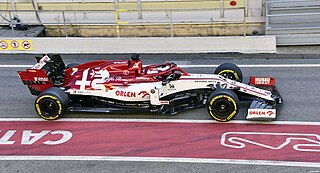
The Alfa Romeo Racing C39 is a Formula One car constructed by Alfa Romeo Racing to compete in the 2020 Formula One World Championship. The car was driven by Kimi Räikkönen and Antonio Giovinazzi, returning for their second year with the team. Robert Kubica acted as the team's reserve driver. The car was planned to make its competitive debut at the 2020 Australian Grand Prix, but this was delayed when the race was cancelled and the next three events in Bahrain, Vietnam and China were postponed in response to the COVID-19 pandemic. The C39 made its debut at the 2020 Austrian Grand Prix.

The Alfa Romeo C42 is a Formula One car designed and built by Alfa Romeo to compete in the 2022 Formula One World Championship. The C42 is built to the new generation of technical regulations, originally intended for introduction in 2021.

